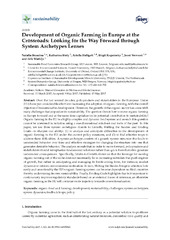| dc.contributor.author | Brzezina, Natalia | |
| dc.contributor.author | Biely, Katharina | |
| dc.contributor.author | Helfgott, Ariella | |
| dc.contributor.author | Kopainsky, Birgit | |
| dc.contributor.author | Vervoort, Joost | |
| dc.contributor.author | Mathijs, Erik | |
| dc.date.accessioned | 2017-11-07T10:12:43Z | |
| dc.date.available | 2017-11-07T10:12:43Z | |
| dc.date.issued | 2017-05-15 | |
| dc.Published | Brzezina N, Biely, Helfgott, Kopainsky B, Vervoort, Mathijs E. Development of organic farming in Europe at the crossroads: Looking for the way forward through system archetype lenses. Sustainability. 2017;9(5):821 | eng |
| dc.identifier.issn | 2071-1050 | |
| dc.identifier.uri | https://hdl.handle.net/1956/16869 | |
| dc.description.abstract | Over the last several decades, policymakers and stakeholders in the European Union (EU) have put considerable effort into increasing the adoption of organic farming, with the overall objective of its sustainable development. However, the growth of the organic sector has come with many challenges that jeopardize its sustainability. The question then is how to move organic farming in Europe forward and at the same time capitalize on its potential contribution to sustainability? Organic farming in the EU is a highly complex and dynamic food system and as such this question cannot be answered in isolation using a one-dimensional mind-set and tools of the past. In this paper, we use three system archetypes—Limits to Growth, Shifting the Burden and Eroding Goals—to sharpen our ability: (1) to analyze and anticipate difficulties in the development of organic farming in the EU under the current policy measures; and (2) to find effective ways to address these difficulties. A system archetype consists of a generic system structure that leads to unintended behavior over time and effective strategies for changing the structure into one that generates desirable behavior. The analysis reveals that in order to move forward, policymakers and stakeholders should reemphasize fundamental solutions rather than quick fixes that often generate unintended consequences. Specifically, Limits to Growth shows us that the leverage for moving organic farming out of the niche does not necessarily lie in increasing subsidies that push engines of growth, but rather in anticipating and managing its limits arising from, for instance, market dynamics or intrinsic environmental motivation. In turn, Shifting the Burden brings to attention how easily and unnoticeably the EU’s organic farming system can become dependent on third countries thereby undermining its own sustainability. Finally, Eroding Goals highlights that is it important to continuously improve regulatory standards based on an external frame of reference, as otherwise organic farming in the EU will continue on its trajectory towards conventionalization. | en_US |
| dc.language.iso | eng | eng |
| dc.publisher | MDPI | eng |
| dc.rights | Attribution CC BY | eng |
| dc.rights.uri | http://creativecommons.org/licenses/by/4.0 | eng |
| dc.subject | organic food and farming | eng |
| dc.subject | development | eng |
| dc.subject | sustainability | eng |
| dc.subject | challenges | eng |
| dc.subject | system archetypes | eng |
| dc.subject | system dynamics | eng |
| dc.subject | feedback loops | eng |
| dc.subject | policy | eng |
| dc.title | Development of organic farming in Europe at the crossroads: Looking for the way forward through system archetype lenses | eng |
| dc.type | Peer reviewed | en_US |
| dc.type | Journal article | en_US |
| dc.date.updated | 2017-09-28T16:12:31Z | |
| dc.description.version | publishedVersion | |
| dc.rights.holder | Copyright 2017 The Author(s) | en_US |
| dc.identifier.doi | https://doi.org/10.3390/su9050821 | |
| dc.identifier.cristin | 1499973 | |
| dc.source.journal | Sustainability | |
| dc.relation.project | Norges forskningsråd: 217931/F10 | |

